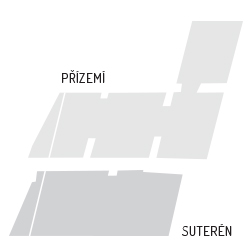RESONANCES
Galerie U Betlémské kaple / Gallery at Bethlehem Chapel
19. February 2015 - 29. March 2015
Curator Petr Vaňous
The exhibition of Jiří Načeradský (1939 - 2014), Josef Bolf (b. 1971) and Lubomír Typlt (b. 1975) presents the work of a former professor and two of his distinguished students. The underlying theme of the project nonetheless brings to the surface something entirely different and more fundamental, which both connects and transcends all three artists. Something that sets them apart from the temporal boundaries which serve to separate generations, so that strict methodology and basic generational causality cease to apply. The exhibition opens up a different reading outside of the standard linear interpretation of so-called art history, as what comes to the fore is the shared preoccupation of all three artists with elaborating a certain visual tradition while simultaneously being engaged in demolishing it and going beyond it.
In order to grasp this tendency which links all three artists and to attempt to define it at least in part, perhaps the most useful method is to go to the very roots and premises of a work of painting, which as a rule lie in the medium of either momentary or definitive drawing. Due to their immediacy and openness, works executed on paper are generally highly revealing in terms of the background of the artist’s specific means of “thinking through form.”
This represents a truly peculiar way of “thinking”, one which is synthetic and comprehensive in nature. The selection of works on exhibition deliberately eschews any set of previously established criteria. It includes drawings of various provenance and character (sketches, studies, gouaches, stand-alone drawings, etc.). The only criterion of the curatorial approach is an emphasis on a kindred resonance of expression which runs through the individual works.
Decisive here is the approach of all three artists to their work, as it shows a similar stance in relating to the past, as something which must be modified and put through the test of contemporary aesthetics. This is not about renouncing the past, but rather to extract from it that which resonates most with the present. And conversely, to integrate heterogeneous elements of contemporaneity within the dismantled matrixes of tradition, so that the painting remains in touch with its own time, while fulfilling its basic function – to break into its own time and render it into form.
In principle, regardless of generation, one can note a parallel approach towards painting with all three artists. Their work re-establishes contact with a reality whose visual appearance is ever-changing, volatile and elusive. Breaking through into “one’s own time” is a difficult task, requiring great patience and a systematic concept of work, with the risk of error or going astray.
Being a painter means upholding the right to an individual stance of resistance, an attitude critical of the consequences of normative operational thought, each time choosing afresh an ever-renewed freedom of expression. A critical attitude towards contemporary culture and the ways of its subversion are the measure of continuous renewal only if one simultaneously succeeds in renewing the individual within a wide spectrum of abilities and possibilities. And this is never possible without the past, which is just as unknown and mysterious as the horizon of the future.
Petr Vaňous







